View in other NatureServe Network Field Guides
NatureServe
Montana
Utah
Wyoming
Idaho
Wisconsin
British Columbia
South Carolina
Yukon
California
New York
California Butterwort - Pinguicula macroceras
Other Names:
Pinguicula vulgaris var. macroceras
State Rank Reason (see State Rank above)
In Montana Pinguicula macroceras is found only in Glacier National Park (GNP). Although plants are relatively protected in GNP, populations are not that common, and many have small numbers. Information on about half of the known locations was collected prior to 1970. There is a potential for impacts where plants occur near trails and roads. Plants have been observed by some botanists as has having low fruit set. Currently data on locations, population sizes, threats, reproduction, as well as, better mapping are needed.
- Details on Status Ranking and Review
Range Extent
ScoreD - 1,000-5,000 sq km (~400-2,000 sq mi)
Comment1,038 square kilometers.
Area of Occupancy
ScoreD - 6-25 4-km2 grid cells
CommentMontana can be divided into 30,390 4x4 square kilometer cells. For this species plant observations occur in 14 of these 4x4 square kilometer cells.
Number of Populations
ScoreB - 6 - 20
Comment30 observations representing about 21 discrete locations.
Environmental Specificity
ScoreA - Very narrow. Specialist or community with key requirements scarce
CommentCoefficient of Conservation value is 9 indicating it exhibits a high fedelity to a narrow range of ecological tolerance and does not tolerate disturbance.
Threats
ScoreD - Low
CommentPotential for impacts occur where plants grow near trails in Glacier National Park. Populations are often small.
Intrinsic Vulnerability
ScoreB - Moderately vulnerable
CommentBumblebeers visit flowers, but successful fruit set rates appear to low.
General Description
PLANTS: Carnivorous, perennial forbs that grow from a fibrous root. Stems are single, leafless (scapose), and terminate into a single flower. Source: Lesica et al. 2012
LEAVES: Simple, succulent, basal leaves with short petioles. Blades are 1–4 cm long, oblong with enrolled, entire margins. Upper surface is sticky from glands (viscid). Source: Lesica et al. 2012
INFLORESCENCE: A solitary purple flower that terminates a bractless peduncle that is 3–12 cm long. Sepals are 3–5 mm long, the 5 lobes longer than the tube. Petals are purple, funnelform, somewhat bilabiate, and 15–25 mm long with a spur of 7–11 mm long. Fruit is a capsule. Source: Lesica et al. 2012
In Montana our plants are variety macroceras (Link.) Herder (Lesica et al. 2012).
Species Range
Montana Range
Range Descriptions
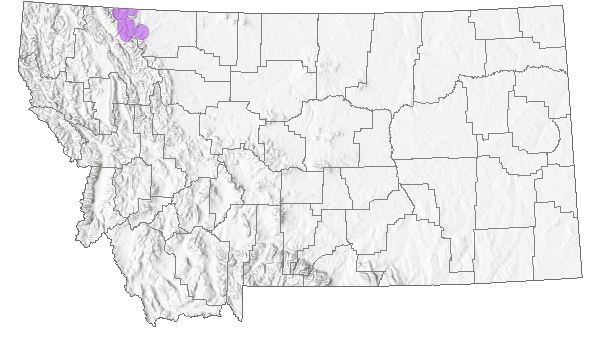
 Native
Native
Range Comments
Circumboreal south to California, Montana, Michigan and New York (Lesica et al. 2012).
Observations in Montana Natural Heritage Program Database
Number of Observations: 32
(Click on the following maps and charts to see full sized version)
Map Help and Descriptions
Relative Density
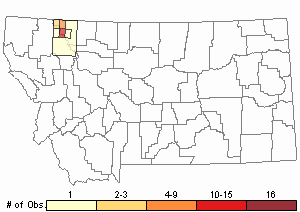
Recency
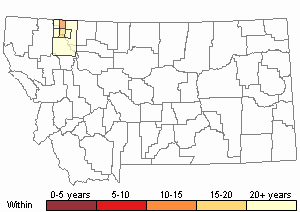
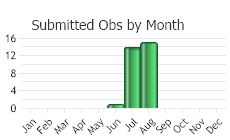
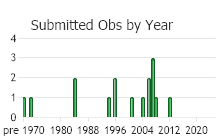
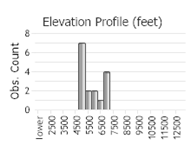 (Observations spanning multiple months or years are excluded from time charts)
(Observations spanning multiple months or years are excluded from time charts)
Habitat
Wet soil of fens, ledges, and stream banks in the subalpine zone or rarely in the alpine zone in Montana (Lescia et al. 2012).
National Vegetation Classification System Groups Associated with this Species
Alpine
Alpine - Sparse and Barren
Wetland and Riparian
Alpine Riparian and Wetland
Wet Meadow and Marsh
Ecology
PLANT-ANIMAL INTERACTIONS
Plants are carnivorous. Insects are caught on the sticky leaves.
Reproductive Characteristics
Plants reproduce from seed.
FRUITS
Capsule: globose, ca. 4 mm high (Lesica et al. 2012).
Stewardship Responsibility
Threats or Limiting Factors
STATE THREAT SCORE REASON
Threat impact not assigned because threats are not documented. (MTNHP Threat Assessment 2021).
References
- Literature Cited AboveLegend:
 View Online Publication
View Online Publication Lesica, P., M.T. Lavin, and P.F. Stickney. 2012. Manual of Montana Vascular Plants. Fort Worth, TX: BRIT Press. viii + 771 p.
Lesica, P., M.T. Lavin, and P.F. Stickney. 2012. Manual of Montana Vascular Plants. Fort Worth, TX: BRIT Press. viii + 771 p. MTNHP Threat Assessment. 2021. State Threat Score Assignment and Assessment of Reported Threats from 2006 to 2021 for State-listed Vascular Plants. Botany Program, Montana Natural Heritage Program, Helena, Montana.
MTNHP Threat Assessment. 2021. State Threat Score Assignment and Assessment of Reported Threats from 2006 to 2021 for State-listed Vascular Plants. Botany Program, Montana Natural Heritage Program, Helena, Montana.
- Additional ReferencesLegend:
 View Online Publication
View Online Publication
Do you know of a citation we're missing? Lesica, P., M.T. Lavin, and P.F. Stickney. 2022. Manual of Montana Vascular Plants, Second Edition. Fort Worth, TX: BRIT Press. viii + 779 p.
Lesica, P., M.T. Lavin, and P.F. Stickney. 2022. Manual of Montana Vascular Plants, Second Edition. Fort Worth, TX: BRIT Press. viii + 779 p.
- Web Search Engines for Articles on "California Butterwort"





